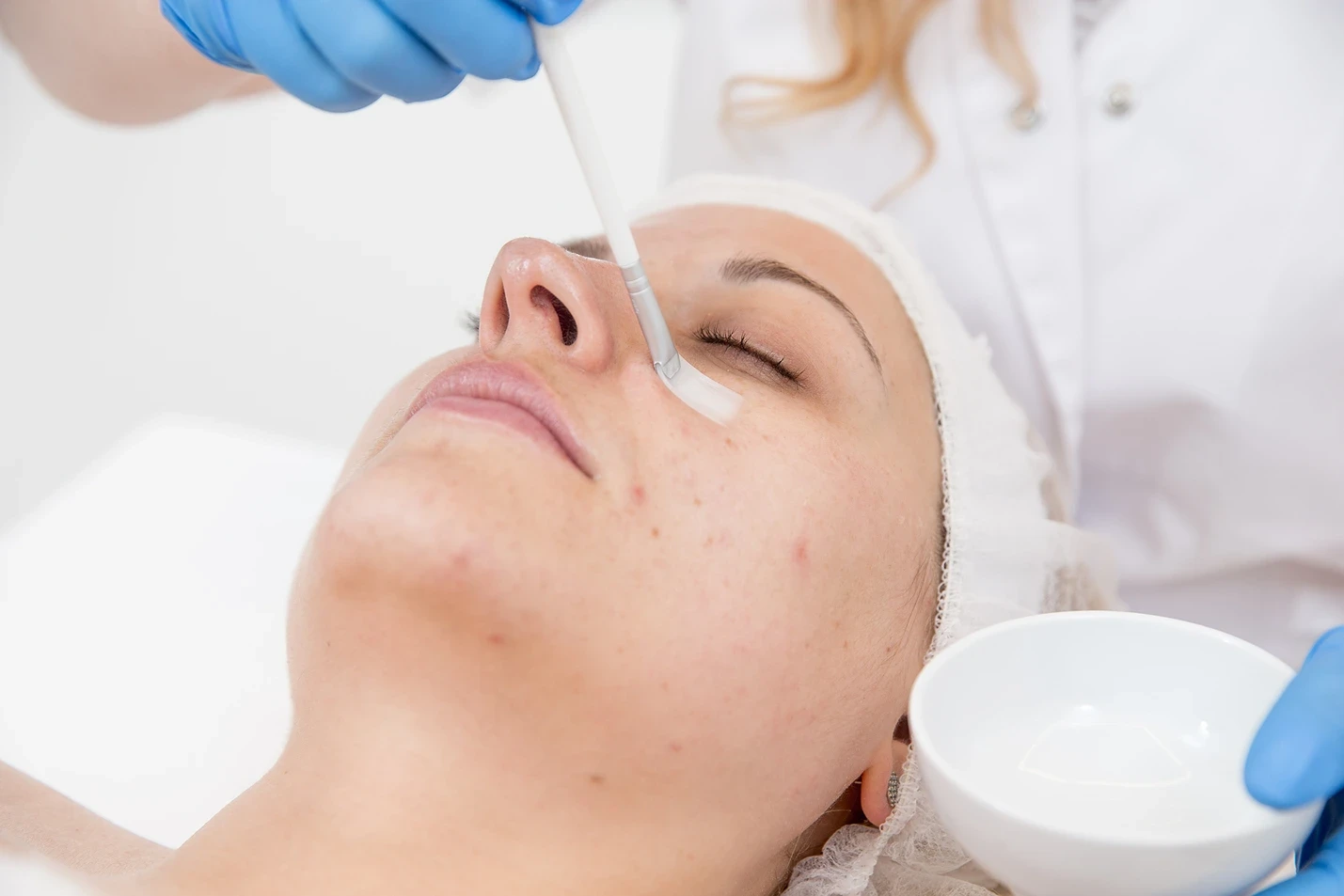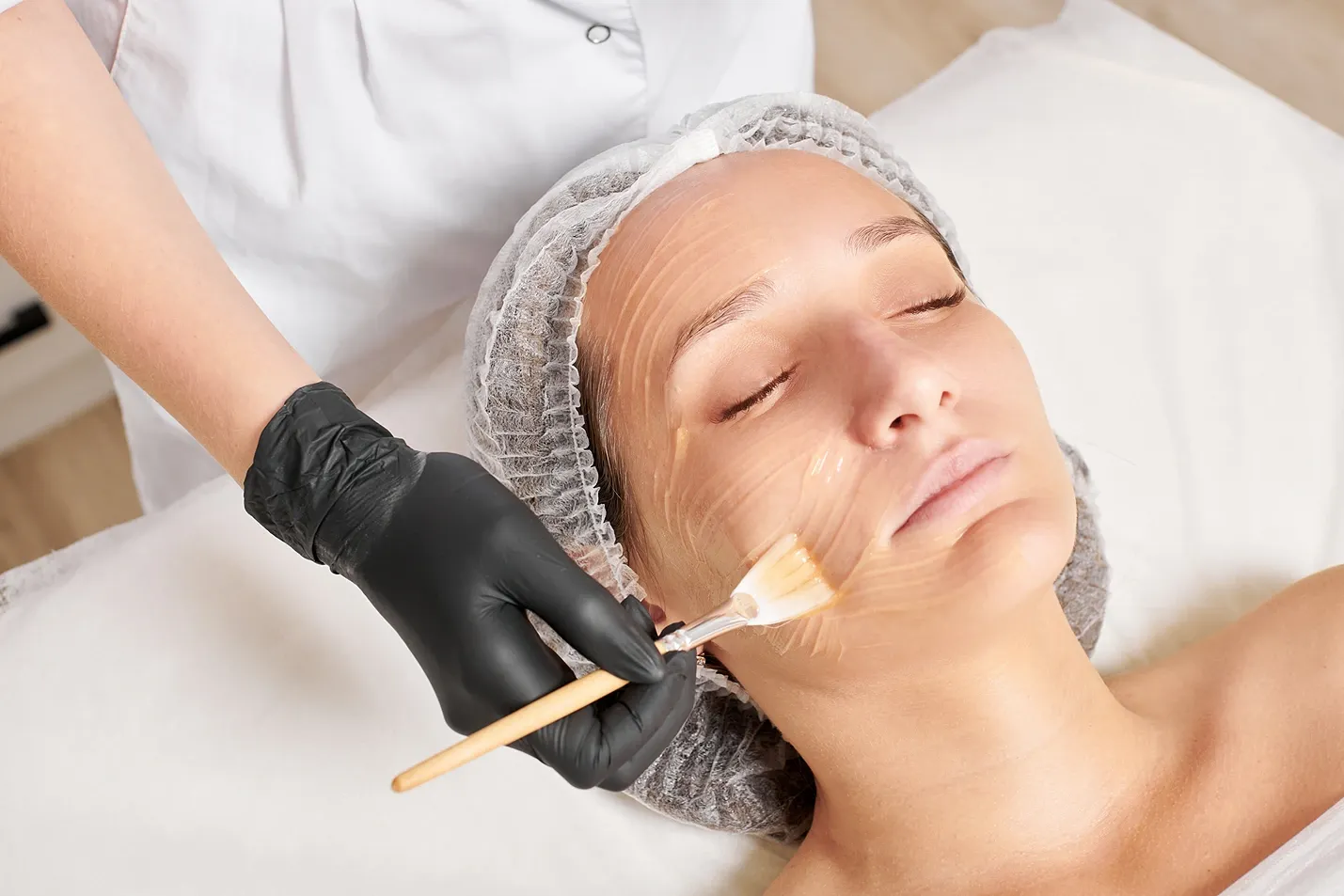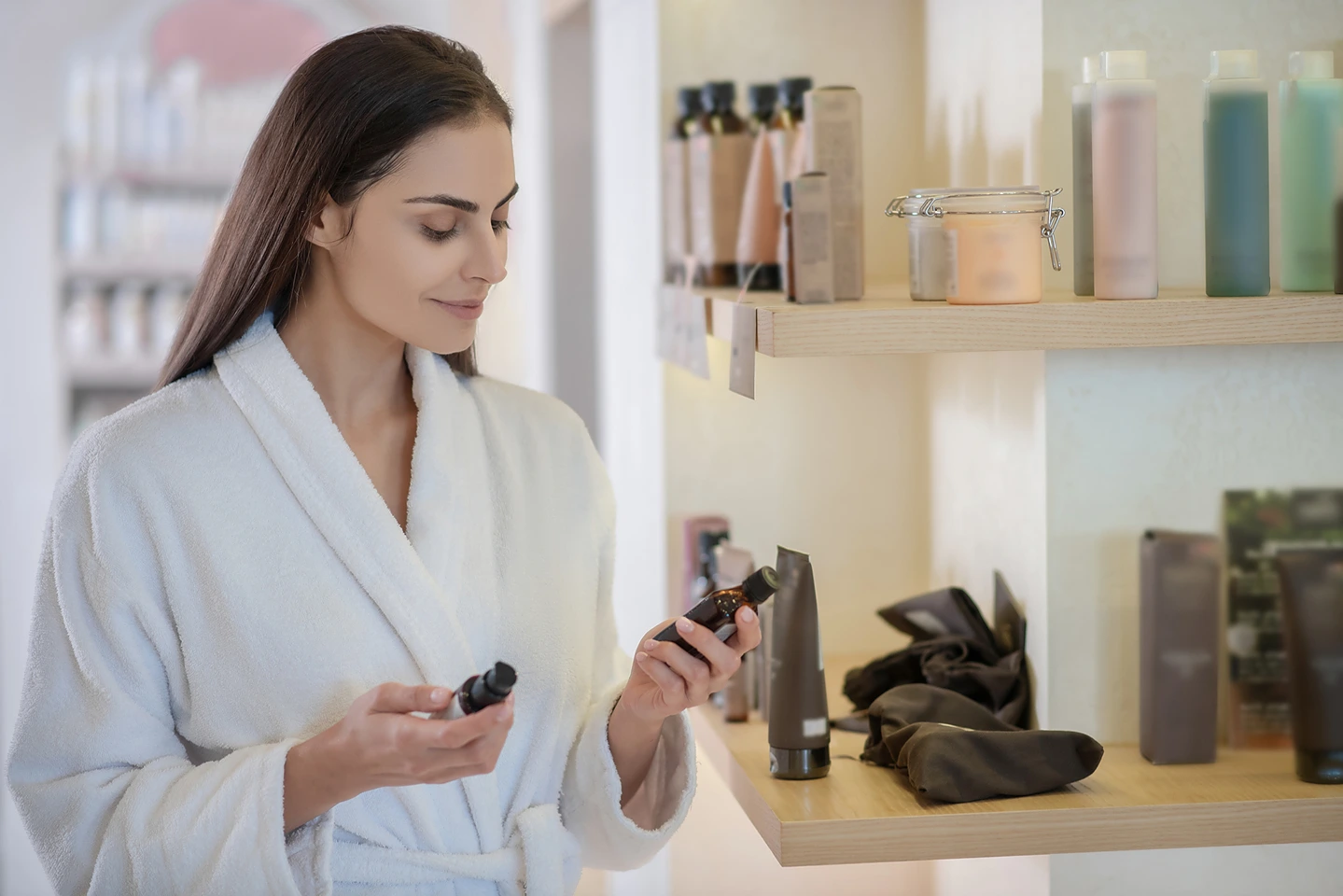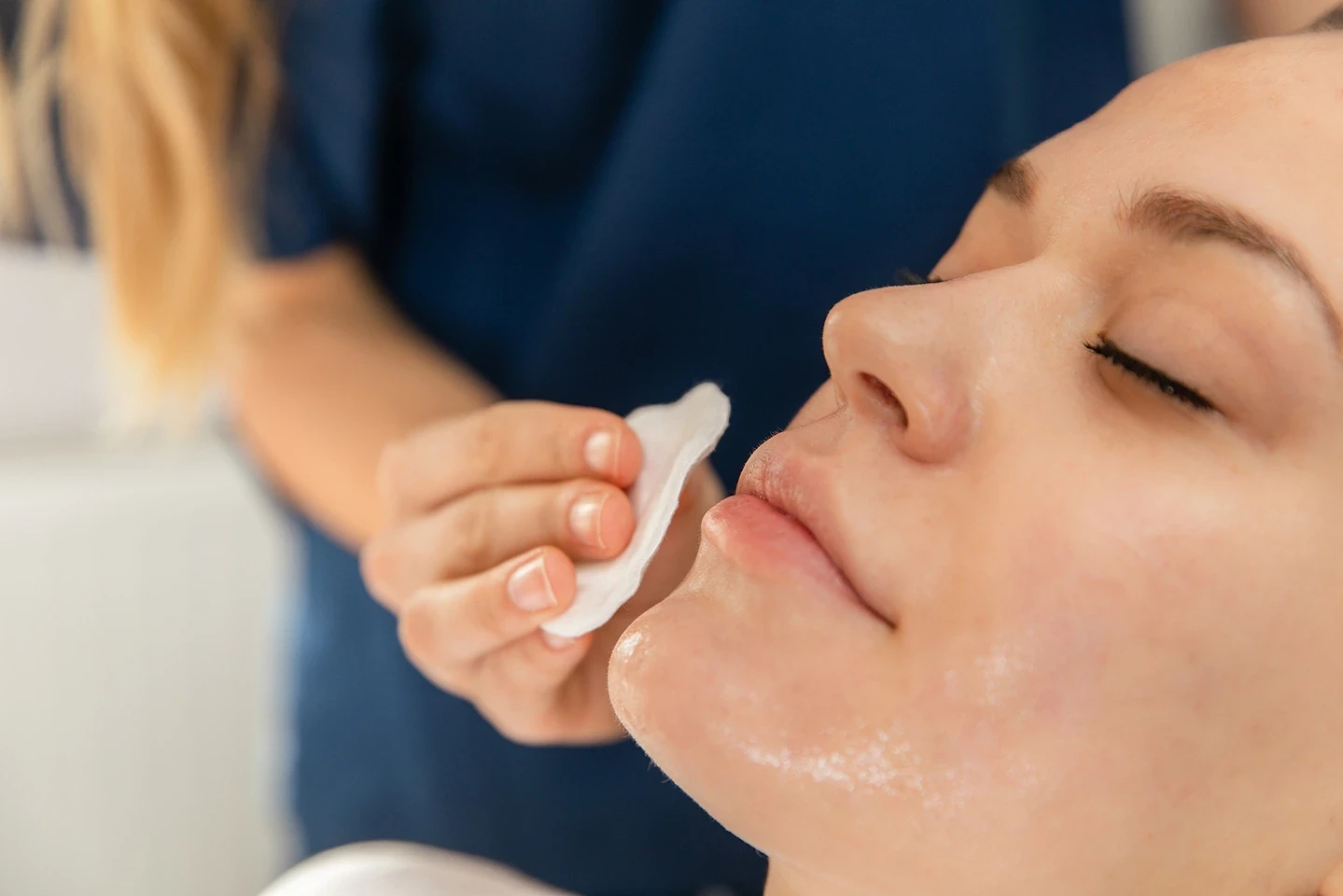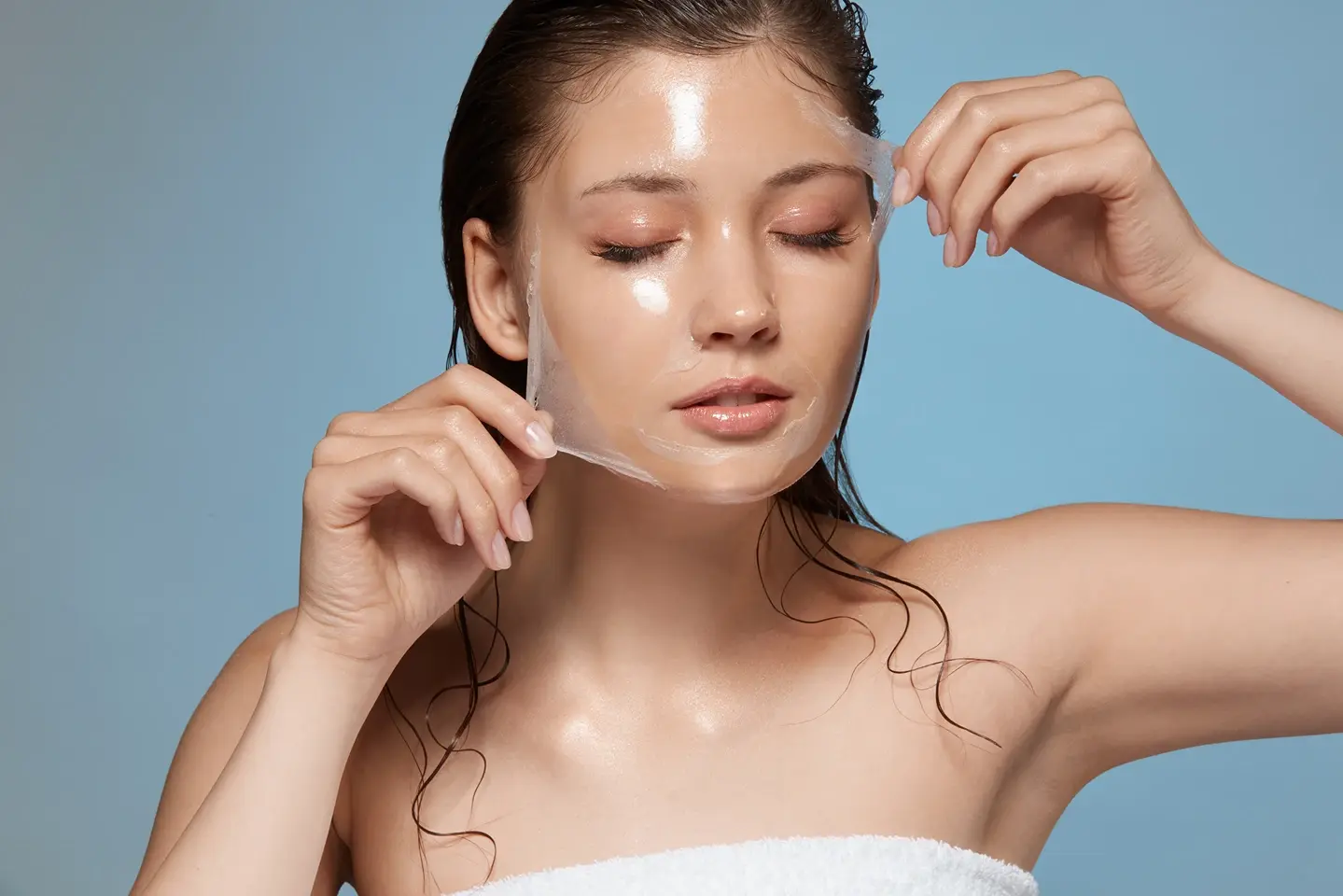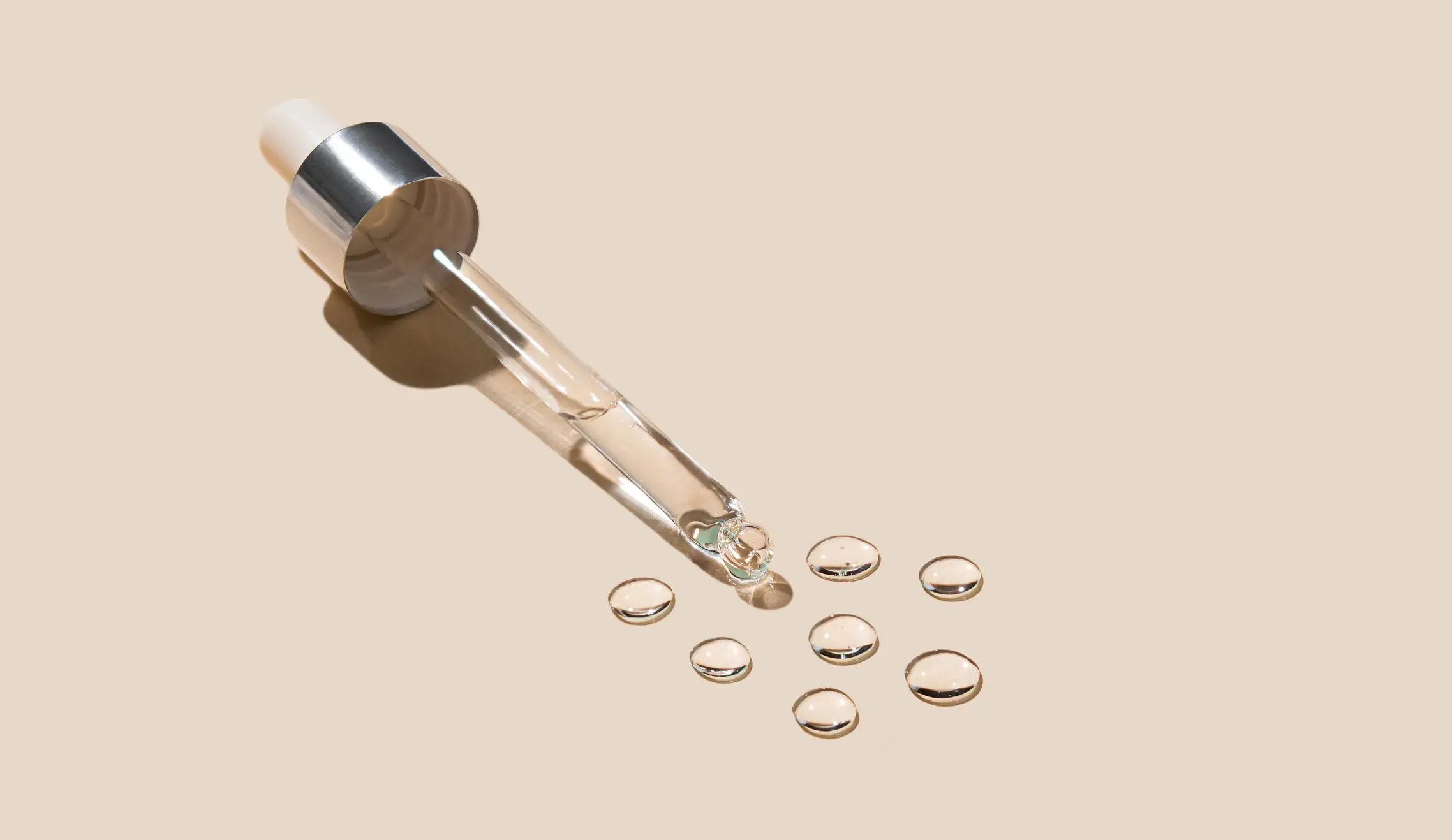Transforming Your Skin with the Power of Acids
Visualize glowing, flawless skin just waiting to emerge from beneath the damaged layer covering it. Chemical peels offer a powerful solution for transforming skin and unveiling its true radiant potential. As one of the most popular skin treatments, chemical peels use acids to exfoliate the outer layer of skin and reveal fresher, newer skin cells underneath.
Chemical peels make it possible to improve skin tone, reduce wrinkles, treat acne, minimize pores, and more — all with minimal downtime and maximum results.
Powerful acids like salicylic acid, glycolic acid, lactic acid and phenol are used for a customized series of procedures to rejuvenate skin and restore a healthy glow. With the growing popularity of chemical peels for conditions ranging from sun damage to melasma, these treatments are revolutionizing the world of dermatology.
Are you ready to uncover the possibilities of chemical peels and see what’s really beneath the surface of your skin? Let’s dive deeper into these transformative procedures and uncover radiant, rejuvenated skin.
Types of Chemical Peels
There are different levels of chemical peels customized for specific skin concerns and goals. Light or superficial peels are a perfect place to start, using mild hydroxy acids like glycolic acid, lactic acid, and citric acid to remove the outermost layer of skin. These light peels are excellent for improving skin tone, brightening complexions, reducing fine lines and wrinkles, and unclogging pores.
Light (Superficial) Peels
Glycolic acid peels, for example, use a lower concentration of glycolic acid to exfoliate the outer epidermal layer. This reveals fresher skin with a healthy glow and smoother texture, ideal for maintenance and touch-up treatments. Lactic acid and citric acid peels are also very gentle, enhancing skin radiance without irritation.
Light peels provide minimal downtime so you can continue with your normal daily routine. There are immediate results, but please keep expectations modest as these peels target the outer layers only. The benefits are subtle yet continual, boosting collagen production and cell turnover with repeated treatments.
Medium Peels
Medium chemical peels use stronger acids like trichloroacetic acid to remove the middle layer of skin. This results in longer lasting exfoliation and more significant improvements compared to light peels. Medium peels are excellent for reducing age spots, scars, wrinkles, discoloration and larger pores. They retexturize skin, boost collagen production and cell turnover to a greater extent than light peels.
While medium peels provide more noticeable results, they also have a longer downtime of 3 to 5 days with peeling, redness, and sensitivity. Sun avoidance is critical during this time to prevent damage to the newly peeled skin. Medium peels may cause some discomfort, scaling, and flaking, so it’s best to start with light peels to build up your tolerance before proceeding to deeper exfoliation.
With repeated medium peels, you can achieve dramatic skin improvements and be on your way to a healthy, youthful-looking complexion. It’s highly recommended to do proper research and consult with a board-certified dermatologist to ensure you are a candidate for chemical peels at a medium depth before proceeding.
Deep Peels
Deep chemical peels, also known as phenol peels, use the strongest acid — phenol — to remove the outer layer of skin. These peels are invaluable for severe wrinkles, deep scars, age spots, and precancerous lesions.
However, deep peels require significant downtime of 7 to 10 days along with pain, irritation, blistering, and scabbing. This deepest level of exfoliation also comes with the highest risk of complications, making it essential to have a dermatologist perform deep chemical peels.
With a deep peel, you gain the most dramatic, transformative results for stubborn skin concerns and a fresh start. But it really depends on dealing with the inconvenience and discomfort during the recovery process.
Deep peels build collagen, smoothly recontour skin, and leave complexions with an even tone and radiant glow. If your skin concerns warrant an intensive procedure, a deep chemical peel can be life-changing.
Conditions Treated by Chemical Peels
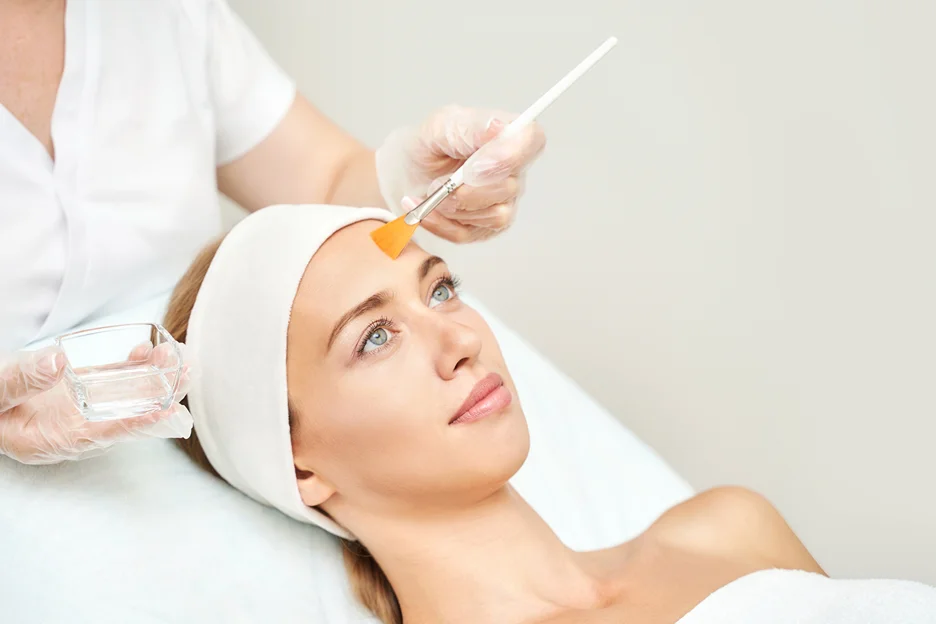
The hands of time leave their mark on skin in the form of wrinkles, age spots, and fine lines. Chemical peels are a leading treatment for minimizing signs of aging in a safe and effective manner. By removing the outer layer of skin, peels boost collagen production and cell regeneration, resulting in firmer, smoother skin over time with repeated treatments.
Aging Signs
Wrinkles around the eyes, mouth, and forehead are common aging concerns targeted by chemical peels. Glycolic acid peels, in particular, help reduce the depth and appearance of superficial wrinkles when performed consistently over several weeks.
For deeper wrinkles, medium or deep peels may be needed to recontour the skin and enhance collagen production in the dermis. Either way, collagen stimulation and increased skin cell turnover are key to diminishing wrinkles with chemical peels.
As individuals age, patches of hyperpigmentation known as age spots or liver spots often develop, giving skin an uneven, mottled look. Salicylic acid peels are very effective at removing age spots in addition to brightening skin and preventing further age spot development. The exfoliation sloughs away the pigmented outer skin layers to achieve an even-toned complexion without the use of harsh bleaches.
Does your mature skin worry you or make you feel distress? Chemical peels can help give your skin a more youthful appearance and Smooth out years of sun exposure or natural aging. By boosting collagen, accelerating cell regeneration and fading age spots, chemical peels tailor the solution to your signs of aging for soft, rejuvenated skin at any age.
Pigmentation Issues
An uneven skin tone causes pigmentation issues like dark patches, age spots, melasma, and post-inflammatory hyperpigmentation. These conditions create a mottled, blotchy complexion and can be difficult to treat without professional procedures. Chemical peels provide an effective solution for remedying pigmentation problems and restoring an even, radiant glow.
By removing the outer layer of skin, chemical peels help fade existing pigmentation as well as prevent melanin production. This results in a smoother, more uniform complexion over repeated treatments. Hydroquinone, kojic acid, azelaic acid, licorice extract, and hydroquinone-containing creams or medications may also be used along with peels to further suppress excess pigment production.
Uneven skin tone can be caused by sun damage, use of tanning beds, pregnancy, medication use, or hormonal changes. Melasma, in particular, is a pigmented patch that develops on the forehead, cheeks, chin or nose and can be stubborn and persistent. Salicylic acid peels or glycolic acid peels are very effective at removing the outer skin layer and diminishing melasma without irritation. Repeated peels under the care of a dermatologist can significantly fade or even clear melasma over time.
Brown spots or age spots caused by sun exposure or aging also benefit from chemical peels. The removal of the pigmented outer layer along with increased collagen production boosts vibrancy and smoothness. For severe cases of age spots, medium depth peels may need to be performed under medical supervision to attain optical clarity.
Acne Scars and Skin Texture
Acne or other skin conditions can often lead to acne scars, rough patches, or an uneven skin texture. No matter your skin type, chemical peels provide a solution for smoothing skin and reducing the appearance of scars.
By removing the outer layer of skin, peels stimulate collagen production and cell regeneration beneath the new skin layer. This helps to gradually fade acne scars, soften rough patches, and create an even skin surface over repeated treatments.
Deep acne scars, pitted scars or severe damage may require medium or deep peels performed by a board-certified dermatologist to significantly improve texture. Glycolic acid, trichloroacetic acid, or phenol peels can effectively resurface the skin and boost collagen for acne scar reduction when administered properly by a professional.
Lactic acid or salicylic acid peels are better suited for most skin types and concerns as they provide gentle exfoliation and smoothening with minimal irritation.
Rough, bumpy skin on the back of the hands, arms, legs or anywhere else can benefit from exfoliation with glycolic acid, salicylic acid or lactic acid chemical peels. The peels dissolve the outer layer of skin cells to soften texture, reduce appearance of bumpiness and make skin smoother to the touch.
Repeated treatments are often needed for severe rough patches, but you can expect noticeable improvement from just a few chemical peels.
Chemical Peel Precautions and Contraindications
While chemical peels are generally a safe and effective treatment, there are some important precautions to keep in mind before undergoing any peel procedure. Consulting with a board-certified dermatologist is critical to determine if you’re an ideal candidate for chemical peels and find the solution that’s right for your specific skin concerns and needs.
Some factors that can affect your candidacy or outcome include:
- Skin type: Peels may cause irritation for sensitive skin or cause hyperpigmentation in darker skin tones. Lighter peels are best suited for most skin types, while deeper peels require tailored expertise.
- Sun/tanning bed exposure: Recent sun or tanning bed use increases the risk of post-inflammatory hyperpigmentation. Avoid excessive sun exposure/tanning for several weeks before and after any peel.
- Skin conditions: Conditions like eczema, psoriasis, cold sores or herpes can increase risks of infection, scarring or poor healing. Discuss any chronic skin conditions with your dermatologist before scheduling peel procedures.
- Family history: The risk of scarring or keloids runs in families. If others in your family have a history of hypertrophic scarring, deeper peels may pose risks. Lighter peels tend to have less risk of scarring for those with a family history.
- Medications: Certain acne medications or birth control pills may increase sensitivity. Your dermatologist can recommend guidance on dosage or usage before proceeding with peel treatments.
- Post-procedure reactions: After any peel, expect peeling, flaking, redness or blistering which indicate the solution is working to slough away damaged skin layers. Severe pain, infection or poor healing require immediate follow up.
Precautions ensure you achieve softer, smoother skin with minimal risks or side effects. Be honest with your dermatologist about your medical history, skin type, lifestyle and any other factors influencing your skin health.
When used properly under medical supervision, chemical peels provide outstanding results with little danger. But risks are present, especially with deeper procedures, so discussions with your board-certified dermatologist are essential.
Potential Side Effects and Complications
While chemical peels are generally considered a low-risk procedure, deeper peels in particular do carry possibilities of side effects and complications. Consulting with an experienced board-certified dermatologist helps minimize risks by determining the most appropriate peel type and depth for your needs.
Potential Side Effects of Chemical Peels
| Skin redness and irritation | Mild redness and irritation are common after peels and fade quickly with proper care and avoidance of sun/heat exposure. Severe pain, itching, or blistering require immediate follow-up. |
| Skin peeling and sensitivity | Temporary peeling and sensitivity show the peel is working, but peels should not blister skin. See your dermatologist for any signs of infection. |
| Hyperpigmentation | Dark patches may develop on skin with higher concentrations of melanin like the face, neck, or hands. Hydroquinone helps prevent hyperpigmentation and can fade any that develops. |
| Uneven skin tone | Multiple procedures on similar areas of concern or improper follow-up care can lead to an uneven complexion. Having all peels performed by the same board-certified dermatologist helps ensure consistency and beautiful, long-lasting results. |
Potential Complications of Chemical Peels
| Keloid or hypertrophic scarring | Deeper peels, especially phenol peels, carry a higher risk of scarring for those prone to developing keloids or hypertrophic scars. Lighter peels minimize scarring risks. |
| Actinic keratosis or precancerous growths | Deeper peels may irritate or damage precancerous skin lesions. Thorough skin exams by your dermatologist before any peel procedures are critical to check for any suspicious growths which should be removed first. |
| Infection | Lack of proper wound care or unhygienic procedures/products pose risks of infection which can become serious if left untreated. Only allow peels to be performed by a board-certified dermatologist for your safety. |
| Alteration of skin sensation | Deeper peels, especially phenol peels, may cause a loss of sensation which is usually temporary but can be permanent in severe cases. Discuss risks thoroughly with your dermatologist based on your desired outcomes. |
With proper precautions, selection of peel type/depth, experienced administration by a board-certified dermatologist and diligent follow up care, chemical peels achieve radiant, rejuvenated skin with minimal dangers of side effects or complications.
But some possibilities do exist, especially for deeper peels, so do thorough research and discuss all concerns with your dermatologist before proceeding with any treatment.
Special Considerations for Skin Types
All skin types from very fair to deepest black can benefit from chemical peels, but the procedure may need to be tailored to individual needs. Consulting with a board-certified dermatologist experienced in treating diverse skin types ensures the best, safest results. Some special considerations for skin types include:
- Fair or white skin: Prone to hyperpigmentation or post-inflammatory hyperpigmentation. Gentle, light peels using lactic acid or salicylic acid help exfoliate without irritation. Hydroquinone can also help prevent excess pigmentation. Sun avoidance is critical before and after any peel.
- Sun-damaged skin: Requires specialized peels to effectively rejuvenate sun-damaged skin without further irritation. Lactic acid, kojic acid or azelaic acid peels are often used and prescribed based on severity of sun damage and skin tone. Deeper peels may be needed for severe cases but more cautiously selected.
- Acne-prone skin: Requires peels specifically formulated to unclog pores without exacerbating acne breakouts. Salicylic acid, benzoyl peroxide, and alpha hydroxy acid peels help remove dead skin cells, unclog pores and reduce inflammation without irritation. Peels are usually performed by a dermatologist experienced in treating acne for best results.
- Darker skin tones (Fitzpatrick types IV-VI): Prone to hypopigmentation or depigmentation, especially with higher concentrations of certain acids like hydroquinone. Kojic acid, azelaic acid, lactic acid, and low-dose hydroquinone help gradually brighten skin with minimal impact on skin tone. Lower concentrations and less frequent, shorter duration treatments are typically used. Sun protection is crucial before any peel.
- Sensitive skin: Requires the most gentle, moisturizing peels to soften skin without irritation or discomfort. Hydrating acids like lactic acid or kojic acid, or enzyme peels help exfoliate sensitive skin gradually with soothing and anti-inflammatory effects. Conducting a patch test and determining your threshold for irritation is important before pursuing any peel.
While chemical peels provide life-changing results for all skin types, extra precautions must be taken to account for individual skin characteristics and sensitivities. When treated by an experienced board-certified dermatologist, chemical peels can be tailored to your exact needs and used to transcend skin type barriers for incomparable radiance and clarity. But doing so with expert guidance is key.
Preparing for and Aftercare of Chemical Peels
Preparing for chemical peels begins with consulting an experienced board-certified dermatologist to determine the most effective and safe peel for your specific concerns and skin type.
Pre-treatment Preparation
Once your peel type, depth, and schedule have been established, there are some important steps to take before the procedure:
- Avoid sun exposure and tanning beds: Recent sun damage or tanning bed use prevents the best results from your chemical peel and increases risks of irritation or hyperpigmentation. Avoid direct sun exposure for several weeks before your procedure.
- Stop cosmetic treatments: Use of cosmetic solutions, topical treatments containing hydroquinone, trichloroacetic acid, azelaic acid, kojic acid or glycolic acid should be stopped under your dermatologist’s recommendation. Typically 2-4 weeks off these treatments leads up to a chemical peel.
- Stop skin care routines with alpha hydroxy acids: Glycolic acid or lactic acid skin care products may be discontinued as recommended by your dermatologist to allow your skin barrier to repair before the exfoliation of a chemical peel. Two weeks without alpha hydroxy acids before a peel is typical.
- No waxing, depilatory creams or botulinum toxin injections: These cosmetic procedures can damage new skin growth and cause irritation. Stop waxing, creams and Botox injections 2-4 weeks before a chemical peel as directed.
- Take over-the-counter pain relievers: Mild pain relievers can help minimize discomfort from peeling or irritation following your chemical peel. Taking an anti-inflammatory medication beforehand as directed by your dermatologist is advisable.
- Arrange time off work: Downtime is needed after chemical peels for recovery and optimal results. You will want to schedule time off work or responsibilities that require strenuous activity. Typical downtime ranges from 3 to 7 days depending on peel depth.
- Stock up on supplies: Have supplies on hand before your peel like moisturizers, over-the-counter hydrocortisone cream, aloe vera gel, eye cream, lip balm and gentle cleansers. These help hydrate, soothe and support healing skin after your procedure.
Proper preparation leads to simpler recovery, faster healing and more stunning results from your chemical peel. Be sure to follow all recommendations from your board-certified dermatologist for pre-treatment steps to take and continue that care and caution following your procedure to achieve healthy, rejuvenated skin.
Post-treatment Care and Recovery
Careful post-treatment care and recovery lead to healthier, rejuvenated skin after chemical peels. Following recommendations from your board-certified dermatologist helps minimize risks of complications while promoting healing and optimal results. Some key things to keep in mind after your chemical peel include:
- Avoid sun and heat exposure: Sun damage and heat prevent new skin growth and can cause irritation, hyperpigmentation or severe burning. Stay out of the sun completely for several weeks after a chemical peel.
- Use broad-spectrum sun protection: When outside, use an SPF 30 or higher broad-spectrum sunscreen. Wear hats, sunglasses and protective clothing like sleeves and pants when possible. Sun protection is critical even after peeling fades to continue seeing results.
- Keep skin well hydrated: Apply fragrance-free moisturizers, aloe vera gel, hyaluronic acid serums and lubricating ointments frequently to hydrate skin and speed healing. Extra hydration is key, especially for the first few days.
- Apply antibiotic ointment: An over-the-counter antibiotic ointment helps prevent infection if damaged skin has a tendency to get infected. Follow directions from your dermatologist on antibiotic use after a chemical peel.
- Take an over-the-counter pain reliever as needed: Minor discomfort from peeling, redness or irritation can be managed with an NSAID like ibuprofen, acetaminophen or naproxen. Only use as directed to avoid stomach issues.
- Use hydrocortisone cream for inflammation: A low-dose hydrocortisone cream helps reduce inflammation, redness and swelling after a chemical peel. Follow directions from your dermatologist on hydrocortisone use.
- Gently wash with a mild cleanser: Wash gently with a mild cleanser, lukewarm water and cotton pads or a soft washcloth. Avoid scrubbing skin for the first few days. Pat dry instead of rubbing vigorously with a towel.
- Keep new skin clean and avoid irritants: New skin sloughs off as recovery progresses. Continue gentle cleansing, moisturizing and sun protection. Avoid harsh skincare products, fragrances, scratchy fabrics or anything else that could irritate sensitive new skin.
- See follow up appointments: See your dermatologist for follow up appointments as directed to monitor healing progress, provide additional recommendations and determine if any touch up chemical peels are needed.
Taking good care of your skin after a chemical peel leads to healthy new skin cell growth and longevity of results. Be sure to follow your dermatologist’s aftercare recommendations closely for the best outcomes from your cosmetic procedure. With time and diligence, the dramatic results from your chemical peel will become more apparent.
Conclusion
Chemical peels help improve skin vitality, integrity and vibrant radiance through controlled exfoliation and collagen stimulation at every skin type. By removing the outer layer of skin, chemical peels reduce wrinkles, fade age spots and hyperpigmentation, soften scars and rough texture, tighten pores, brighten skin tone and create an even surface.
While chemical peels are generally a safe and effective cosmetic treatment, some risks do exist like irritation, scarring or altering skin sensation depending on depth of peel and individual susceptibilities.
Consulting with an experienced board-certified dermatologist is critical to determine candidacy, customize treatment and maintain safety. Your dermatologist can select specific peel agents, types and depths personalized to your unique skin concerns and needs for optimal results with minimal risks.
Age spots, wrinkles, sun damage and dull, uneven skin no longer limit you to an aging appearance. Save money on bargain basement cosmetics and procedures that do not achieve life-changing outcomes.
Invest in yourself for lasting beauty and radiance with chemical peels customized by a professional. With professional guidance, safe and effective at-home treatments are possible as well using recommended products between medical procedures.
Combining the benefits of professional chemical peels with well-guided at-home care leads to continual improvement in skin health, tone and texture over time. Your skin deserves tailored treatment from experienced medical professionals for outcomes beyond comparison. chemical peels transcend age, skin type and damage to restore a natural glow and youthful vibrancy from within.
Schedule a Free Consultation at CosMedic LaserMD
Don’t let wrinkles, acne scars, or pigmentation issues hold you back any longer. Discover the potential of chemical peels at CosMedic LaserMD, where our skilled practitioners will create the perfect treatment plan for your specific concerns. Take the first step towards a renewed complexion – contact us now.


